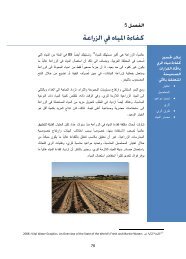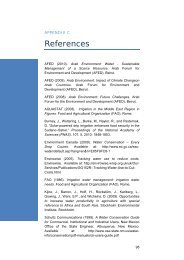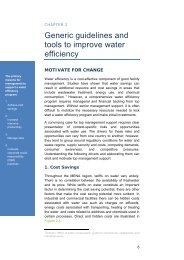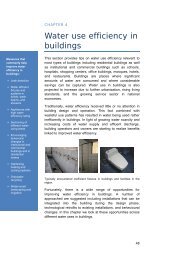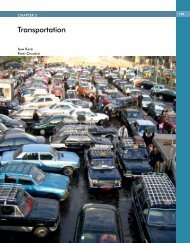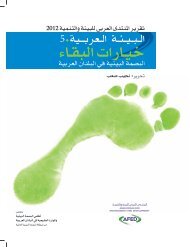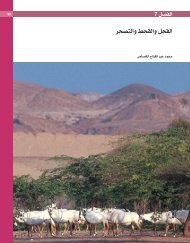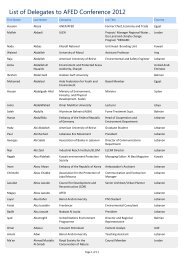Impact of Climate Change on Arab Countries - (IPCC) - Working ...
Impact of Climate Change on Arab Countries - (IPCC) - Working ...
Impact of Climate Change on Arab Countries - (IPCC) - Working ...
You also want an ePaper? Increase the reach of your titles
YUMPU automatically turns print PDFs into web optimized ePapers that Google loves.
96<br />
CHAPTER 7<br />
HUMAN HEALTH<br />
- Diseases transmitted by rodents: These too<br />
tend to increase during heavy rainfall and<br />
flooding because rainfall and flooding increase<br />
the number <str<strong>on</strong>g>of</str<strong>on</strong>g> rodents. A good illustrati<strong>on</strong><br />
would be the Hantavirus Pulm<strong>on</strong>ary<br />
Syndrome (<strong>IPCC</strong>, 2007).<br />
III. ADAPTATION PRACTICES<br />
The vulnerability <str<strong>on</strong>g>of</str<strong>on</strong>g> human health to climate<br />
change is a functi<strong>on</strong> <str<strong>on</strong>g>of</str<strong>on</strong>g> three factors: sensitivity<br />
which is a measure <str<strong>on</strong>g>of</str<strong>on</strong>g> the extent to which health,<br />
natural systems, and social systems are sensitive to<br />
climate change as well as the characteristics <str<strong>on</strong>g>of</str<strong>on</strong>g> the<br />
populati<strong>on</strong>; exposure to climate related hazards;<br />
and adaptati<strong>on</strong> measures which are the measures<br />
applied to reduce the burden <str<strong>on</strong>g>of</str<strong>on</strong>g> a specific adverse<br />
health outcome. <strong>Arab</strong> countries may be low direct<br />
c<strong>on</strong>tributors to climate change but they are at<br />
high risk <str<strong>on</strong>g>of</str<strong>on</strong>g> its c<strong>on</strong>sequences, especially as it<br />
relates to health risks. C<strong>on</strong>sequently, <strong>Arab</strong> countries<br />
must take adaptive measures to reduce the<br />
burden <str<strong>on</strong>g>of</str<strong>on</strong>g> disease or other related negative health<br />
outcomes related to climate change (Kovats,<br />
2003). Those populati<strong>on</strong>s who do not or cannot<br />
adapt will be the most vulnerable to climate<br />
change.<br />
Mitigati<strong>on</strong> measures are implemented at multiple<br />
levels to prevent ‘disasters’ or minimize their<br />
impact. In the case <str<strong>on</strong>g>of</str<strong>on</strong>g> heat waves, for example,<br />
mitigati<strong>on</strong> measures include adopting building<br />
designs that take into c<strong>on</strong>siderati<strong>on</strong> future heat<br />
waves due to climate change especially in <strong>Arab</strong><br />
cities, such as in the United <strong>Arab</strong> Emirates and<br />
the Sultanate <str<strong>on</strong>g>of</str<strong>on</strong>g> Oman, which are expanding at a<br />
very fast pace. Buildings should limit the frequency,<br />
intensity, and durati<strong>on</strong> <str<strong>on</strong>g>of</str<strong>on</strong>g> high-temperature<br />
episodes. As cities grow and merge so do their<br />
heat islands. Urban heat islands in large <strong>Arab</strong><br />
cities can be reduced through urban planning and<br />
envir<strong>on</strong>mental preservati<strong>on</strong> such as reducing<br />
automobile use, enhancing public transportati<strong>on</strong>,<br />
planting trees, protecting biodiversity, and the<br />
like. Encouraging more envir<strong>on</strong>mentally sustainable<br />
development by reducing dependence <strong>on</strong><br />
cars, and cutting wasteful resource and energy use<br />
is a needed policy. Heat wave warning systems to<br />
warn the populati<strong>on</strong> about upcoming heat waves<br />
are also recommended. However, the effectiveness<br />
<str<strong>on</strong>g>of</str<strong>on</strong>g> warning systems for extreme events<br />
depends <strong>on</strong> individuals’ awareness and their willingness<br />
to take appropriate acti<strong>on</strong>. Individuals<br />
can reduce their exposure by adjusting outdoor<br />
activity, modifying indoor air temperature, or<br />
dressing properly. In the case <str<strong>on</strong>g>of</str<strong>on</strong>g> other hazards or<br />
geographic c<strong>on</strong>texts, such as floods, community<br />
awareness and preparedness becomes very important<br />
if it is technically or financially difficult to<br />
c<strong>on</strong>struct flood embankments or create new flood<br />
overflow routes.<br />
It is necessary that <strong>Arab</strong> countries implement<br />
measures at the country and regi<strong>on</strong>al levels in<br />
public health preparedness to face such calamities.<br />
In fact, such measures are still a priority to<br />
this regi<strong>on</strong> regardless <str<strong>on</strong>g>of</str<strong>on</strong>g> climate change c<strong>on</strong>siderati<strong>on</strong>s.<br />
A preparedness plan must address the<br />
three phases <str<strong>on</strong>g>of</str<strong>on</strong>g> a disaster: pre-disaster phase (e.g.,<br />
mitigati<strong>on</strong>; awareness; warning systems), disaster<br />
phase (e.g., resp<strong>on</strong>se; health care facilities), and<br />
post-disaster phase (e.g., rehabilitati<strong>on</strong>; l<strong>on</strong>g term<br />
impact; evaluati<strong>on</strong>). At a minimum, the elements<br />
<str<strong>on</strong>g>of</str<strong>on</strong>g> a public health preparedness system must<br />
include the following:<br />
1) Hazard mapping<br />
This is a crucial element <str<strong>on</strong>g>of</str<strong>on</strong>g> any preparedness plan<br />
where at-risk areas and vulnerable populati<strong>on</strong>s are<br />
clearly mapped. At-risk areas include arid lands,<br />
coastal cities pr<strong>on</strong>e to sea-level rise, areas around<br />
dams and irrigati<strong>on</strong> projects, and overcrowded<br />
cities. Vulnerable populati<strong>on</strong>s include poor people<br />
who most likely have poor health with high<br />
infant mortality rates and low life expectancies,<br />
and tend to reside in areas or houses that are most<br />
vulnerable to climate change. The latter was illustrated<br />
in the latest flooding episode in Yemen<br />
which mainly affected the poorer populati<strong>on</strong>s.<br />
Populati<strong>on</strong>s in <strong>Arab</strong> countries that rely <strong>on</strong> n<strong>on</strong>irrigated<br />
agriculture are also likely to be vulnerable<br />
to climate change. Nomadic tribes living in<br />
the Sahara in North Africa and the Gulf area are<br />
also likely to be vulnerable to climate change.<br />
Such informati<strong>on</strong> will help policy makers determine<br />
priorities and decide <strong>on</strong> the adequate provisi<strong>on</strong><br />
and distributi<strong>on</strong> <str<strong>on</strong>g>of</str<strong>on</strong>g> resources, including<br />
health care resources and facilities. Geographical<br />
Informati<strong>on</strong> Systems (GIS) are an important tool<br />
in this endeavour. GIS links together geographical<br />
informati<strong>on</strong> (such as geographic coordinates<br />
<str<strong>on</strong>g>of</str<strong>on</strong>g> a specific point or the outline <str<strong>on</strong>g>of</str<strong>on</strong>g> an administrative<br />
regi<strong>on</strong>) to some relevant informati<strong>on</strong> about



